1. Misra A, Khurana L. Obesity-related non-communicable diseases: South Asians vs White Caucasians. Int J Obes. 2011; 35:167–187.
2. Korean National Health and Nutrition Survey. National health and nutrition survey 8th 2nd year (2020). Prevalence of chronic disease [Internet]. Cheongju: Korea Disease Control and Prevention Agency;2022. cited 2022 September 29. Available from:
https://knhanes.kdca.go.kr/knhanes/sub01/sub01_05.do#s50201
.
3. Yang YS, Han BD, Han K, Jung JH, Son JW. Taskforce Team of the Obesity Fact Sheet of the Korean Society for the Study of Obesity. Obesity fact sheet in Korea, 2021: Trends in obesity prevalence and obesity-related comorbidity incidence stratified by age from 2009 to 2019. J Obes Metab Syndr. 2022; 31:169–177. PMID:
35770450.
4. Lazarus JV, Mark HE, Anstee QM, Arab JP, Batterham RL, Castera L, Cortez-Pinto H, Crespo J, Cusi K, Dirac MA, et al. Advancing the global public health agenda for NAFLD: a consensus statement. Nat Rev Gastroenterol Hepatol. 2022; 19:60–78. PMID:
34707258.
5. Laddu D, Dow C, Hingle M, Thomson C, Going S. A review of evidence-based strategies to treat obesity in adults. Nutr Clin Pract. 2011; 26:512–525. PMID:
21947634.
6. An J, Yoon SR, Lee JH, Kim H, Kim OY. Importance of adherence to personalized diet intervention in obesity related metabolic improvement in overweight and obese Korean adults. Clin Nutr Res. 2019; 8:171–183. PMID:
31384596.
7. Kim H, Yoon E, Kim OY, Kim EM. Short-term effects of eating behavior modification on metabolic syndrome-related risks in overweight and obese Korean adults. J Obes Metab Syndr. 2022; 31:70–80. PMID:
35296564.
8. Kim OY, Chung JY, Song J. Effect of resveratrol on adipokines and myokines involved in fat browning: perspectives in healthy weight against obesity. Pharmacol Res. 2019; 148:104411. PMID:
31449976.
9. Shin MJ, Jang Y, Koh SJ, Chae JS, Kim OY, Lee JE, Ordovas JM, Lee JH. The association of SNP276G>T at adiponectin gene with circulating adiponectin and insulin resistance in response to mild weight loss. Int J Obes. 2006; 30:1702–1708.
10. Frayling TM, Timpson NJ, Weedon MN, Zeggini E, Freathy RM, Lindgren CM, Perry JR, Elliott KS, Lango H, Rayner NW, et al. A common variant in the
FTO gene is associated with body mass index and predisposes to childhood and adult obesity. Science. 2007; 316:889–894. PMID:
17434869.
11. Scuteri A, Sanna S, Chen WM, Uda M, Albai G, Strait J, Najjar S, Nagaraja R, Orrú M, Usala G, et al. Genome-wide association scan shows genetic variants in the
FTO gene are associated with obesity-related traits. PLoS Genet. 2007; 3:e115. PMID:
17658951.
12. Dina C, Meyre D, Gallina S, Durand E, Körner A, Jacobson P, Carlsson LM, Kiess W, Vatin V, Lecoeur C, et al. Variation in
FTO contributes to childhood obesity and severe adult obesity. Nat Genet. 2007; 39:724–726. PMID:
17496892.
13. Prakash J, Mittal B, Srivastava A, Awasthi S, Srivastava N. Association of
FTO rs9939609 SNP with obesity and obesity- associated phenotypes in a north Indian population. Oman Med J. 2016; 31:99–106. PMID:
27168919.
14. Ağagündüz D, Gezmen-Karadağ M. Association of
FTO common variant (rs9939609) with body fat in Turkish individuals. Lipids Health Dis. 2019; 18:212. PMID:
31810473.
15. Mehrdad M, Fardaei M, Fararouei M, Eftekhari MH. The association between
FTO rs9939609 gene polymorphism and anthropometric indices in adults. J Physiol Anthropol. 2020; 39:14. PMID:
32398148.
16. Karasawa S, Daimon M, Sasaki S, Toriyama S, Oizumi T, Susa S, Kameda W, Wada K, Muramatsu M, Fukao A, et al. Association of the common fat mass and obesity associated (
FTO) gene polymorphism with obesity in a Japanese population. Endocr J. 2010; 57:293–301. PMID:
20051647.
17. Chang YC, Liu PH, Lee WJ, Chang TJ, Jiang YD, Li HY, Kuo SS, Lee KC, Chuang LM. Common variation in the fat mass and obesity-associated (
FTO) gene confers risk of obesity and modulates BMI in the Chinese population. Diabetes. 2008; 57:2245–2252. PMID:
18487448.
18. Bressler J, Kao WH, Pankow JS, Boerwinkle E. Risk of type 2 diabetes and obesity is differentially associated with variation in
FTO in whites and African-Americans in the ARIC study. PLoS One. 2010; 5:e10521. PMID:
20502638.
19. Vasan SK, Karpe F, Gu HF, Brismar K, Fall CH, Ingelsson E, Fall T.
FTO genetic variants and risk of obesity and type 2 diabetes: a meta-analysis of 28,394 Indians. Obesity (Silver Spring). 2014; 22:964–970. PMID:
23963770.
20. Li H, Kilpeläinen TO, Liu C, Zhu J, Liu Y, Hu C, Yang Z, Zhang W, Bao W, Cha S, et al. Association of genetic variation in
FTO with risk of obesity and type 2 diabetes with data from 96,551 East and South Asians. Diabetologia. 2012; 55:981–995. PMID:
22109280.
21. Liu C, Mou S, Cai Y.
FTO gene variant and risk of overweight and obesity among children and adolescents: a systematic review and meta-analysis. PLoS One. 2013; 8:e82133. PMID:
24278475.
22. Cha SW, Choi SM, Kim KS, Park BL, Kim JR, Kim JY, Shin HD. Replication of genetic effects of
FTO polymorphisms on BMI in a Korean population. Obesity (Silver Spring). 2008; 16:2187–2189. PMID:
18551112.
23. Ministry of Health and Welfare. Partial revision of regulations on genetic testing items that can be directly conducted by genetic testing institutions other than medical institutions [Internet]. Sejong: Ministry of Health and Welfare;2020. cited 2022 October 26. Available from:
https://www.mohw.go.kr/react/jb/sjb0406vw.jsp
.
24. Page MJ, McKenzie JE, Bossuyt PM, Boutron I, Hoffmann TC, Mulrow CD, Shamseer L, Tetzlaff JM, Akl EA, Brennan SE, et al. The PRISMA 2020 statement: an updated guideline for reporting systematic reviews. BMJ. 2021; 372:n71. PMID:
33782057.
25. von Elm E, Altman DG, Egger M, Pocock SJ, Gøtzsche PC, Vandenbroucke JP. STROBE Initiative. The Strengthening the Reporting of Observational Studies in Epidemiology (STROBE) statement: guidelines for reporting observational studies. Ann Intern Med. 2007; 147:573–577. PMID:
17938396.
26. Li X, Song F, Jiang H, Zhang M, Lin J, Bao W, Yao P, Yang X, Hao L, Liu L. A genetic variation in the fat mass- and obesity-associated gene is associated with obesity and newly diagnosed type 2 diabetes in a Chinese population. Diabetes Metab Res Rev. 2010; 26:128–132. PMID:
20186840.
27. Zhao NN, Dong GP, Wu W, Wang JL, Ullah R, Fu JF.
FTO gene polymorphisms and obesity risk in Chinese population: a meta-analysis. World J Pediatr. 2019; 15:382–389. PMID:
31124039.
28. Hotta K, Nakata Y, Matsuo T, Kamohara S, Kotani K, Komatsu R, Itoh N, Mineo I, Wada J, Masuzaki H, et al. Variations in the
FTO gene are associated with severe obesity in the Japanese. J Hum Genet. 2008; 53:546–553. PMID:
18379722.
29. Loos RJ, Yeo GS. The bigger picture of
FTO: the first GWAS-identified obesity gene. Nat Rev Endocrinol. 2014; 10:51–61. PMID:
24247219.
31. Expert Consultation WH. WHO Expert Consultation. Appropriate body-mass index for Asian populations and its implications for policy and intervention strategies. Lancet. 2004; 363:157–163. PMID:
14726171.
32. Peng S, Zhu Y, Xu F, Ren X, Li X, Lai M.
FTO gene polymorphisms and obesity risk: a meta-analysis. BMC Med. 2011; 9:71. PMID:
21651756.
33. Sonestedt E, Roos C, Gullberg B, Ericson U, Wirfält E, Orho-Melander M. Fat and carbohydrate intake modify the association between genetic variation in the
FTO genotype and obesity. Am J Clin Nutr. 2009; 90:1418–1425. PMID:
19726594.
34. Rampersaud E, Mitchell BD, Pollin TI, Fu M, Shen H, O’Connell JR, Ducharme JL, Hines S, Sack P, Naglieri R, et al. Physical activity and the association of common
FTO gene variants with body mass index and obesity. Arch Intern Med. 2008; 168:1791–1797. PMID:
18779467.
35. Leońska-Duniec A, Jastrzębski Z, Zarębska A, Maciejewska A, Ficek K, Cięszczyk P. Assessing effect of interaction between the
FTO A/T polymorphism (rs9939609) and physical activity on obesity-related traits. J Sport Health Sci. 2018; 7:459–464. PMID:
30450255.
36. Liaw YC, Liaw YP, Lan TH. Physical activity might reduce the adverse impacts of the
FTO gene variant rs3751812 on the body mass index of adults in Taiwan. Genes (Basel). 2019; 10:354. PMID:
31075924.
37. Vimaleswaran KS, Li S, Zhao JH, Luan J, Bingham SA, Khaw KT, Ekelund U, Wareham NJ, Loos RJ. Physical activity attenuates the body mass index-increasing influence of genetic variation in the
FTO gene. Am J Clin Nutr. 2009; 90:425–428. PMID:
19553294.
38. Andreasen CH, Stender-Petersen KL, Mogensen MS, Torekov SS, Wegner L, Andersen G, Nielsen AL, Albrechtsen A, Borch-Johnsen K, Rasmussen SS, et al. Low physical activity accentuates the effect of the
FTO rs9939609 polymorphism on body fat accumulation. Diabetes. 2008; 57:95–101. PMID:
17942823.
39. Cho YS, Go MJ, Kim YJ, Heo JY, Oh JH, Ban HJ, Yoon D, Lee MH, Kim DJ, Park M, et al. A large-scale genome-wide association study of Asian populations uncovers genetic factors influencing eight quantitative traits. Nat Genet. 2009; 41:527–534. PMID:
19396169.
40. Huang W, Sun Y, Sun J. Combined effects of
FTO rs9939609 and MC4R rs17782313 on obesity and BMI in Chinese Han populations. Endocrine. 2011; 39:69–74. PMID:
21063808.
41. Kim YJ, Lee HS, Kim YK, Park S, Kim JM, Yun JH, Yu HY, Kim BJ. Association of metabolites with obesity and type 2 diabetes based on
FTO genotype. PLoS One. 2016; 11:e0156612. PMID:
27249024.
42. den Hoed M, Westerterp-Plantenga MS, Bouwman FG, Mariman EC, Westerterp KR. Postprandial responses in hunger and satiety are associated with the rs9939609 single nucleotide polymorphism in
FTO. Am J Clin Nutr. 2009; 90:1426–1432. PMID:
19793853.
43. Wardle J, Carnell S, Haworth CM, Farooqi IS, O’Rahilly S, Plomin R. Obesity associated genetic variation in
FTO is associated with diminished satiety. J Clin Endocrinol Metab. 2008; 93:3640–3643. PMID:
18583465.
44. de Luis DA, Aller R, Izaola O, Primo D, Urdiales S, Romero E. Effects of a hgh-protein/low-carbohydrate diet versus a standard hypocaloric diet on weight and cardiovascular risk factors: role of a genetic variation in the rs9939609
FTO gene variant. J Nutrigenet Nutrigenomics. 2015; 8:128–136. PMID:
26457804.
45. Qi Q, Kilpeläinen TO, Downer MK, Tanaka T, Smith CE, Sluijs I, Sonestedt E, Chu AY, Renström F, Lin X, et al.
FTO genetic variants, dietary intake and body mass index: insights from 177,330 individuals. Hum Mol Genet. 2014; 23:6961–6972. PMID:
25104851.
46. Lee HJ, Kim IK, Kang JH, Ahn Y, Han BG, Lee JY, Song J. Effects of common
FTO gene variants associated with BMI on dietary intake and physical activity in Koreans. Clin Chim Acta. 2010; 411:1716–1722. PMID:
20650268.
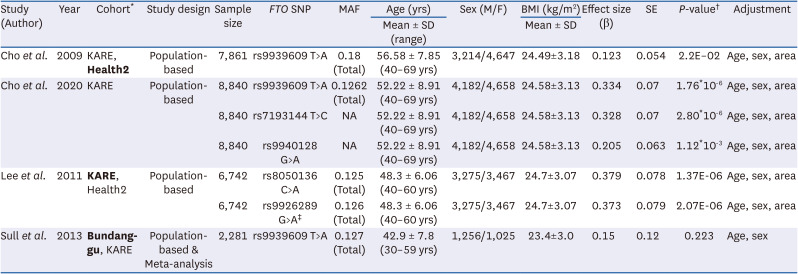
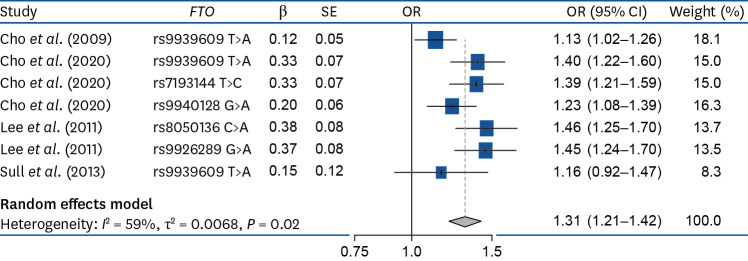
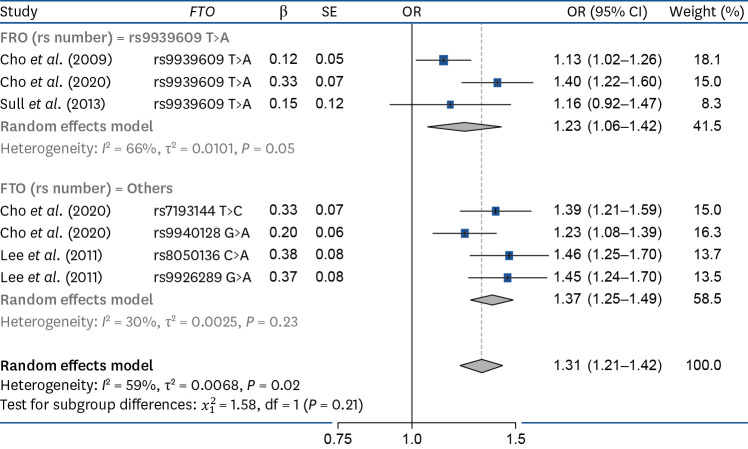




 PDF
PDF Citation
Citation Print
Print



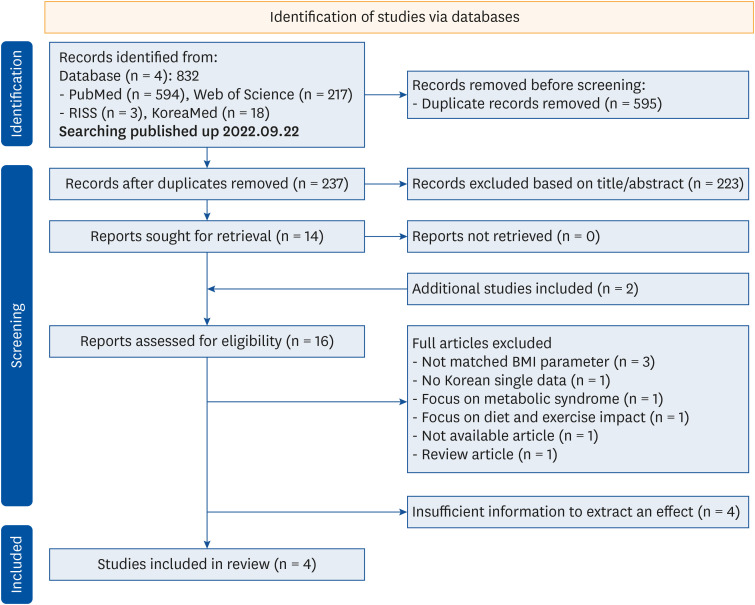
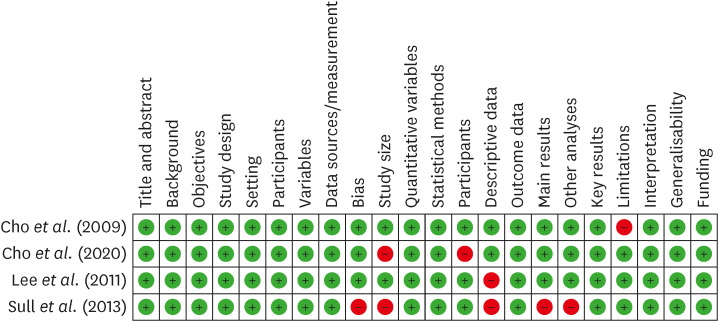
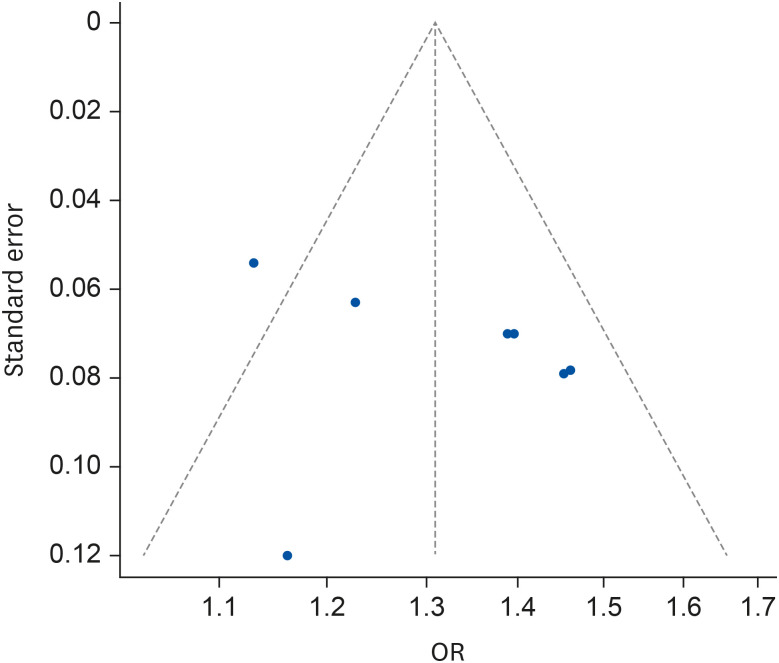
 XML Download
XML Download